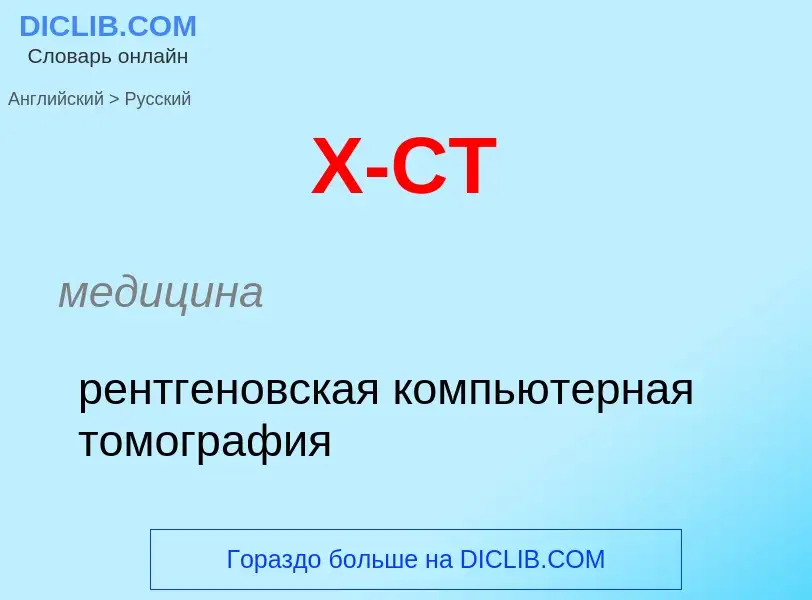Tradução e análise de palavras por inteligência artificial ChatGPT
Nesta página você pode obter uma análise detalhada de uma palavra ou frase, produzida usando a melhor tecnologia de inteligência artificial até o momento:
- como a palavra é usada
- frequência de uso
- é usado com mais frequência na fala oral ou escrita
- opções de tradução de palavras
- exemplos de uso (várias frases com tradução)
- etimologia
X-CT - tradução para russo
медицина
рентгеновская компьютерная томография
медицина
компьютерная томография
томоденситография
медицина
рентгеновская томография
Definição
Wikipédia
X-ray microtomography, like tomography and X-ray computed tomography, uses X-rays to create cross-sections of a physical object that can be used to recreate a virtual model (3D model) without destroying the original object. The prefix micro- (symbol: µ) is used to indicate that the pixel sizes of the cross-sections are in the micrometre range. These pixel sizes have also resulted in the terms high-resolution X-ray tomography, micro-computed tomography (micro-CT or µCT), and similar terms. Sometimes the terms high-resolution CT (HRCT) and micro-CT are differentiated, but in other cases the term high-resolution micro-CT is used. Virtually all tomography today is computed tomography.
Micro-CT has applications both in medical imaging and in industrial computed tomography. In general, there are two types of scanner setups. In one setup, the X-ray source and detector are typically stationary during the scan while the sample/animal rotates. The second setup, much more like a clinical CT scanner, is gantry based where the animal/specimen is stationary in space while the X-ray tube and detector rotate around. These scanners are typically used for small animals (in vivo scanners), biomedical samples, foods, microfossils, and other studies for which minute detail is desired.
The first X-ray microtomography system was conceived and built by Jim Elliott in the early 1980s. The first published X-ray microtomographic images were reconstructed slices of a small tropical snail, with pixel size about 50 micrometers.


![composite]]<ref name="maxcom" /> composite]]<ref name="maxcom" />](https://commons.wikimedia.org/wiki/Special:FilePath/Micro CT analysis of Ti2AlC and Al composite.gif?width=200)






![Types of presentations of CT scans: <br />- Average intensity projection<br />- [[Maximum intensity projection]]<br />- Thin slice ([[median plane]])<br />- [[Volume rendering]] by high and low threshold for [[radiodensity]] Types of presentations of CT scans: <br />- Average intensity projection<br />- [[Maximum intensity projection]]<br />- Thin slice ([[median plane]])<br />- [[Volume rendering]] by high and low threshold for [[radiodensity]]](https://commons.wikimedia.org/wiki/Special:FilePath/CT presentation as thin slice, projection and volume rendering.jpg?width=200)
![[[Commons: Scrollable computed tomography images of a normal brain]]}} [[Commons: Scrollable computed tomography images of a normal brain]]}}](https://commons.wikimedia.org/wiki/Special:FilePath/Computed tomography of human brain - large.png?width=200)



![sagittal]] (lower left), and [[coronal plane]]s (lower right) sagittal]] (lower left), and [[coronal plane]]s (lower right)](https://commons.wikimedia.org/wiki/Special:FilePath/Ct-workstation-neck.jpg?width=200)
 and patient in a CT imaging system.gif?width=200)
.jpg?width=200)



